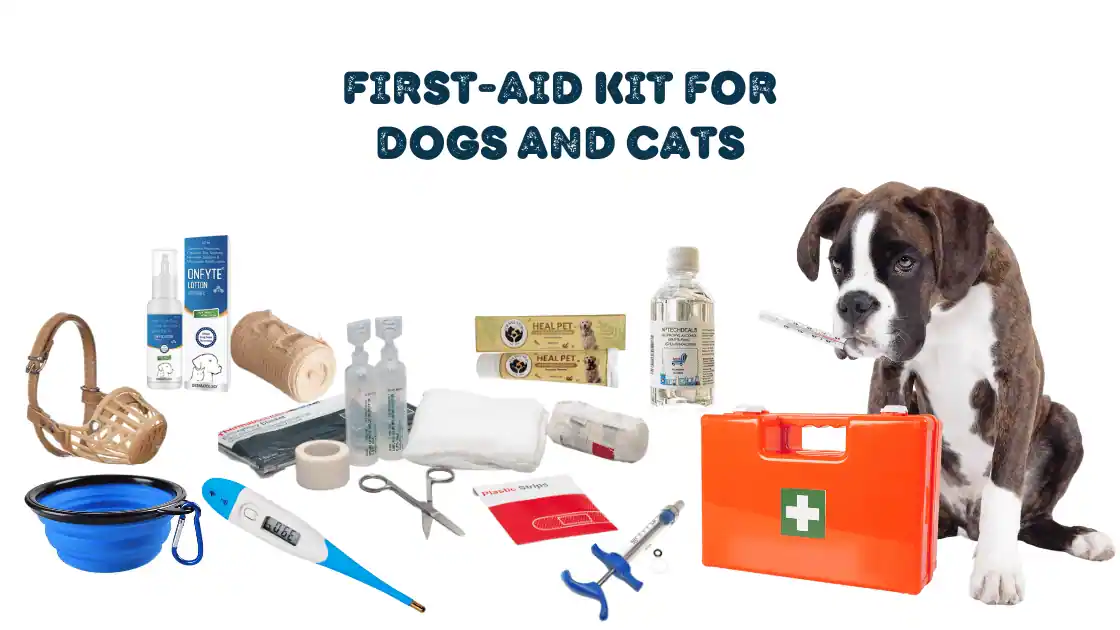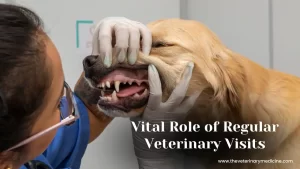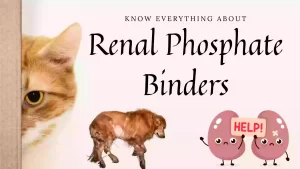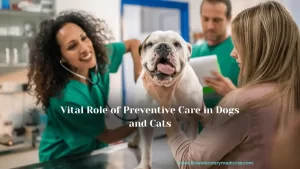Introduction
Pets are important part of our families, and just like humans, they can sometimes face unexpected health emergencies. Having a well-prepared first-aid kit for pets like dogs and cats can make a difference in urgent need or a critical situation. It is more important to have a first aid kit during camping, vacation or travelling with your pet. This article includes the essentials of creating a basic pet first-aid kit, use of basic first aid, and guidance on when to seek professional veterinary care during emergency.
What is First Aid for Pets?
Accidents or unexpected events can happen with pets at anywhere or anytime. First aid for pets involves providing immediate care to furry companions in the event of an injury or sudden illness. The primary goals of pet first aid are always to stabilize the animal’s condition, alleviate pain, and prevent further harm until professional veterinary help is available.
Why Do You Need a Pet First-Aid Kit?
- Immediate Response: Accidents and illnesses can happen at any time, and a well-equipped first-aid kit allows you to provide prompt care when your pet needs it most.
- Prevent Complications: A swift action can prevent minor issues from escalating into major health problems or complications, potentially saving your pet’s life.
- Peace of Mind: Having the tools and knowledge of first aid can help your pet in an emergency. It can ease your anxiety and promote calm, which is essential for your pet’s well-being.
Building Your Pet First-Aid Kit
A basic first aid kit should contain almost all of the essential supplies that your pet may need. A well-organized and fully equipped pet first-aid kit should contain the following essential items in a well labelled container box:
Basic items and their indication for uses:
1. Hydrogen Peroxide (3%):
To induce vomiting (only when instructed by a veterinarian) and cleaning wounds. Use carefully in cats and always speak to your vet before dosing again if your pet doesn’t vomit even after hydrogen peroxide administration. Not all the toxicities can be fixed by inducing vomiting.
2. Activated Charcoal:
It is needed as the antidote of several poisons. It is helpful where vomiting can’t be induced during poisoning and available in the tablet and powder form. Dosage can vary from 1-5 gm per kg of body weight for dogs and cats.
3. Antiseptic Solution:
Solution like Dettol, Betadine, rubbing alcohol or Merbromin are required for cleaning wounds to prevent infections.
In area of high sun light or UV conditions you may also need to carry a dog safe sunscreen which can be applied on nose ears and other sensitive areas.
4. Saline Solution:
0.9% saline or normal saline is required for flushing out debris from eyes or wounds. It can be replaced with Ringer’s lactate if not available.
5. Sterile Gauze Pads and Bandages:
It should be in variety of sizes. It is necessary to dress, protect wounds or control bleeding by applying gentle pressure. Non-adherent sterile pads can also be used. Vet wraps are also a good option to keep in first aid kit.
6. Adhesive Tape:
Different size (1 inch or two inches) adhesive tapes are required for securing bandages. Micropore or porous tapes should also be included for taping or fixing bandages or swabs.
7. Scissors, grooming clippers or safety razor:
A small scissors (possibly blunt end), clipper and razor are required for cutting bandages, clipping of hairs at wound site. Nail clippers/ cutters can also be added to kit and are helpful in case of nail cracks.
8. Digital Thermometer:
To check your pet’s temperature. A flexi-tip thermometer with linger sensor or paediatric one is better for easy use and accurate reading. Normal dog temperature ranges from 100.5°F to 102.5°F; normal cat temperature ranges from 100.0°F to 102.5°F.
9. Tweezers/ Thumb forceps:
These are useful to remove splinters or ticks. Also, can be used for dressing of wounds, taking debris, foreign material or maggots from the wound.
10. Topical Antibiotic Ointment:
To prevent infection in minor cuts, abrasions or scrapes. Powders like Neomycin or Povidone Iodine can also be used for application on local wounds. Alternatives like Manuka Honey Gel, Silver nitrate or colloidal silver, herbal ointments and sprays can also be used for normal wounds and burns.
11. Cotton Balls and Alcohol Swabs:
Useful in cleaning wounds and applying topical medications. These can be kept in a small airtight container. Avoid using alcohol swabs around sensitive areas like eyes.
12. Pet-Friendly Pain Reliever:
Only use medication recommended by your veterinarian and follow the recommended doses. Never give human medication to your pet without professional advice. Paracetamol / acetaminophen administration to cats can be life threatening. If you want to include a NSAID for pain management then always consult your vet for dosage and right drug. e.g. Himpyrin Syrup
13. Latex (or hypoallergenic material) gloves:
Necessary for preventing infection and maintaining cleanliness. Size depends on your hand or free size unsterilized gloves can be used.
14. Cat / Safety Gloves:
It is important to have cat gloves in kit if your pet is cat. Cat gloves are helpful in handling and preventing cat bites.
15. Muzzle:
To prevent self-mutilation or bites during handling. More often required if you are involved in rescue work. Dog or cat can bite or snap when in pain.
16. Towel or Thermal Blanket:
For easy handling, calming the pet and wrapping sometimes in case if additional padding or pressure is required. Large towel or thermal blanket can help in protecting your pet lying on a hot/ cold or hard surface. This can also help in case of hypothermia.
17. Styptic Powder or Stick:
To control haemorrhage in case of accidental injury. Use of clotting agents needs to be applied in small amount using cotton swab or applicator. It can be used on wounds, over-trimmed nails, deep cuts and foot pad injuries. After applying styptic powders put gentle pressure until the bleeding stops or pressure bandaging can help in control bleeding.
In case of injury for fomentation or thermal shock/ hyperthermia/ hypothermia. It can be used in case of sprains, bruises, inflammation, and swellings.
19. Glucose paste/ Powder:
Much needed for the pet who suffer from hypoglycemia, heat stroke or insulin overdose in diabetic mellitus. Pet electrolyte powders can also help in case of dehydration.
20. Penlight or torch with batteries:
Useful for examination or search in dark. Eye, ear and oral cavity can also be examined in case of any possible injury.
21. Petrolium jelly:
Needed for lubrication or application at cracks.
22. Baby dose syringe:
Needed for feeding, water or aspiration of fluid. Can also be used for flushing of superficial or deep wounds.
23. Eye ointment:
Artificial tear gel or lubrication eye gel (carboxy methyl cellulose) should be included to relieve discomfort.
24. Splints:
Two small sized plastic or wooden splints can be useful in management of fractures in limbs and can be used in stabilizing the segments. Too much tight splint or bandage can interfere with blood flow.
25. Collapsible water bowl with carabiner and leash:
This can help dehydrated pets and keeping them secure during hiking. It will also help in preventing heat stroke or hyperthermia due to high environmental temperature.
26. Emergency contact:
Phone numbers of your veterinarian, vet clinic or vet hospital name or emergency vet care facility and address must be kept. You may need to keep your pet’s health, vaccination and other records at once place.
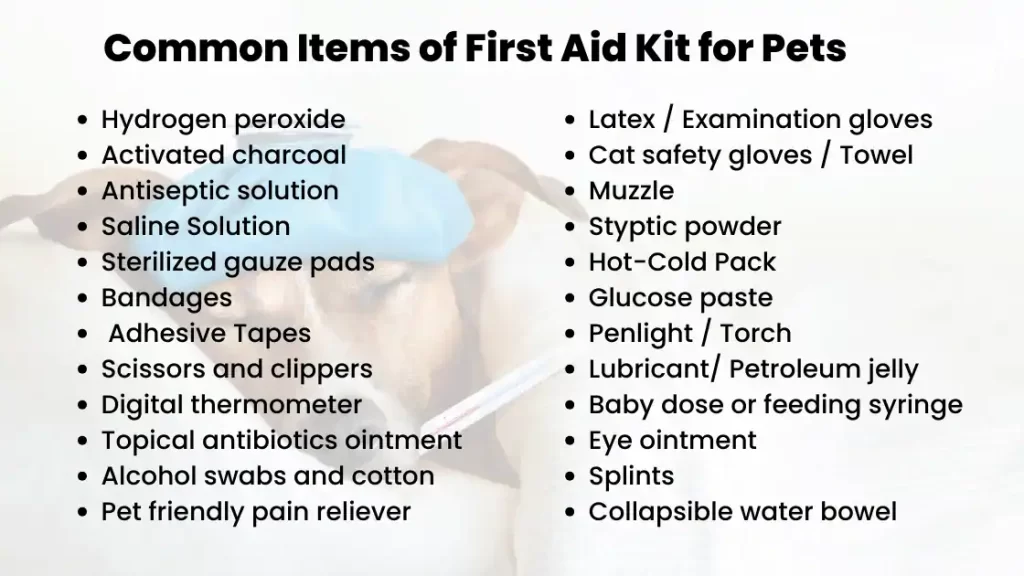
Store all necessary items in a durable, water resistant, shard shell case suitable for home, travel, boating, hiking, hunting, camping and more vacations. It will be suitable for managing first aid for common emergencies like wounds, deep cuts due to sharp metal or glass, bites, heatstroke, hypothermia, poisoning, hit by a vehicle like car, falling from height etc.
Number of items can vary depending on the use or age of the pet. Like a kit for home use will require less items than a kit required for hiking.
Note:
Always check your basic first aid kit prepared for pets for different purpose like camping, general use, vacation or trips time to time. If you find any expired item or medicine then replace it or there is any need of addition of something then include. Try selecting high or good quality items. Always recheck kit if you are traveling with pet. Keep it out of reach of children.
What should not be given?
Giving human drugs without consulting a vet can be life threatening. Paracetamol toxicity and xylitol toxicity are common in cats and dogs respectively due to human medication. Benedryl or Diphenhydramine can be given for calming and treat allergic conditions.
Limitations of first aid Kit:
It is meant for primary treatment but can not help in case of poisonous snake bites, heat stroke, hypovolemia, cardiac stroke, severe trauma, severe anaphylaxis or hypersensitivity reactions etc. Always keep your dog’s age, breed, physical condition or concurrent illness in mind. In these situations, or where unable to understand what has happened to your pet; always take your pet immediately to nearest vet care or emergency facility.
The ABCD of Emergency:
In an serious emergency situation, remember the ABCD rule:
- A: Airway: Ensure the pet’s airway is clear and unobstructed.
- B: Breathing: Check for normal breathing; perform CPR if necessary.
- C: Circulation: Assess the pulse (femoral) and control any bleeding.
- D: Disability: Evaluate the pet’s neurological status and any disability.
When to Seek Professional Veterinary Care
While first aid can be crucial in stabilizing your pet’s condition, it’s essential to recognize when it’s time to seek immediate veterinary care:
**Severe bleeding that can’t be controlled with a bandage.
**Difficulty breathing or loss of consciousness.
**Ingestion of toxic substances.
**Seizures lasting longer than five minutes.
**Fractures or severe injuries.
**Signs of shock (pale gums, rapid heartbeat, shallow breathing).
**Eye injuries.
**Heatstroke or hypothermia.
**Severe vomiting or diarrhea.
**Any unexplained or sudden change in behavior.
FAQs about Pet First Aid
1. Can I use my first-aid kit for humans on my pet?
No, it is essential to have a dedicated pet first-aid kit. Some human medications and supplies may be harmful to animals.
2. How can I learn more about pet first aid?
Many organizations offer pet first-aid courses both online and in-person. Look for courses provided by reputable institutions and veterinarians in your area.
3. Should I muzzle my pet if they are injured?
Muzzling is recommended if your pet is in pain or frightened but be cautious as it may agitate them further. Use a soft muzzle or improvise with a leash or cloth.
4. Can I use human pain relievers for my pet?
Never give human medications to your pet without consulting a veterinarian. Some human pain relievers can be toxic to animals.
5. How often should I check my pet's first-aid kit?
Regularly inspect your kit to ensure that supplies are not expired and are in good condition. Replace any items that have been used or are past their expiration date.
6. What should I do if my pet ingests a toxic substance?
Contact your veterinarian or an emergency animal poison hotline immediately. Do not induce vomiting unless instructed to do so by a professional.
7. Can I perform CPR on my pet?
Yes, CPR can be performed on pets. However, it’s crucial to learn the proper technique through a certified pet first-aid course.
8. How can I keep my pet calm during a medical emergency?
Speak softly, move slowly, and avoid sudden movements. Keep your pet warm and offer comfort while waiting for professional help.
9. Are there any specific considerations for exotic pets?
Yes, each species may have unique medical needs. Consult with a veterinarian who specializes in exotic animals and have a kit tailored to their requirements.
10. Is it advisable to have a pet insurance policy?
Pet insurance can provide financial assistance for unexpected medical expenses. Consider a policy that covers accidents and illnesses.
Conclusion:
A well-prepared pet first-aid kit is an essential tool for every pet owner. It empowers you to respond effectively in emergencies, offering immediate care to your beloved companions when they need it most. Remember to always prioritize your pet’s safety and well-being and consult with a veterinarian for guidance on administering first aid and seeking professional care when necessary. By being informed and proactive, you can help ensure a healthy and happy life for your furry friends.


